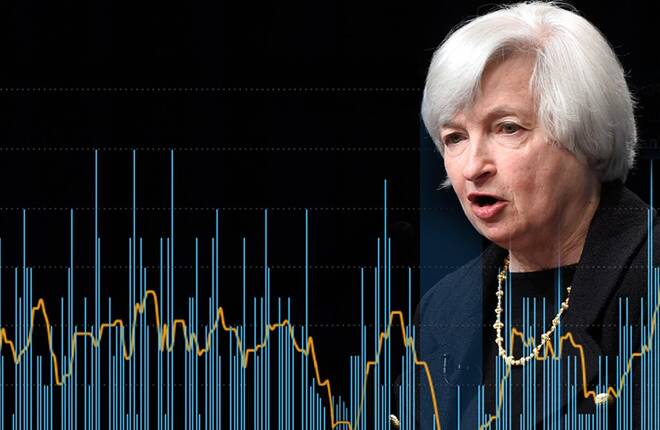Advertisement
Advertisement
Yellen’s Upbeat Tone Couldn’t Change the Bearish Mood of the Financial Markets
By:
Last week’s price action highlighted the difference in opinion between the U.S. Federal Reserve and the financial markets. The Fed expects the U.S.
Last week’s price action highlighted the difference in opinion between the U.S. Federal Reserve and the financial markets. The Fed expects the U.S. economy to continue to grow slowly while investors appear to be looking for global weakness. The Fed may also be on-track for a rate hike in March. Investors are betting the Fed’s next rate hike won’t take place until early 2017.
The differences in opinion were highlighted last week when Fed Chairwoman Janet L. Yellen, delivered a relatively upbeat assessment of the economy to the Senate Banking Committee while investors were dumping stocks and shoveling money into safe havens like government debt and gold.
“A lot has happened” since December when the Fed predicted it would spend 2016 gradually raising rates, Ms. Yellen acknowledged. Some analysts were looking for as many as 4 rate hikes. Yellen also added that risk-averse investors could disrupt slow-and-steady economic growth.
Yellen continued to deliver her upbeat message when asked about the risk of a recession. She responded that anything is possible but “expansions don’t die of old age.” She also made it clear that Fed officials were still debating when, not whether, they should raise rates again.
“We will meet in March, and our committee will carefully deliberate about what impact these developments have had,” Ms. Yellen told Congress, referring to the market turmoil and next month’s meeting of the Federal Open Market Committee (FOMC). “Today I think it’s premature to render a judgment.”
Yellen also addressed a question regarding the cause of the recent market turmoil. She said she did not think the Fed contributed significantly to the convulsions in financial markets by its December decision to raise its benchmark interest rate for the first time since the financial crisis. “I don’t think it’s mainly our policy,” she told the Committee.
The issue of negative interest rates also came up in light of recent moves by the Bank of Japan and the European Central Bank. Yellen downplayed the possibility that the Fed would seek to provide new stimulus by imposing negative interest rates. However, the idea was not completely discarded. “I wouldn’t take those off the table, but we would have work to do to judge whether they would be workable her,” she said.
Stocks broke sharply last week with several indices reaching multi-month lows as investors aggressively shifted money into gold, lower-yielding currencies and into U.S. Treasurys.
U.S. Treasury yields plunged last week as worries over global growth and the effectiveness of central bank policy sparked demand for safe-haven assets and as global equity markets dropped sharply. The yield on the benchmark 10-year note fell to its lowest level in more than three years.
Prices of Fed Fund futures, used to predict future policy decisions by the U.S. Federal Reserve, surged across the board as investors further cut back expectations that the central bank can engineer another rate hike soon. Short-term futures, a proxy for expectations for the Fed, now show the market sees no chance of a rate increase this year.
The lower U.S. Treasury Yields and falling equity prices helped drive April Gold futures to its highest price since May 2015. Similar price action took place in the EUR/USD which soared to its highest level since mid-October 2015. The USD/JPY fell to 110.972, prompting warnings of a possible intervention by the Bank of Japan.
The week ended on a positive note with stocks ending their 5-day losing streak. European markets were lifted by a strong recovery in the shares of Deutsche Bank, which rose more than 1.8% and a strong showing by German Preliminary GDP which came in at 0.3%.
U.S. investors reacted positively to U.S. retail sales, which rose 0.2 percent in January, above the 0.1 percent expected gain. Import prices in the U.S. fell 1.1 percent, less than expected.
The volatile crude oil market also managed to put in a strong performance on Friday on renewed rumors of a possible agreement to cut production. A proposed deal for a cease-fire in Syria, which may help to bring the Saudis to the table for an OPEC deal, also helped underpin prices at the end of the week.
About the Author
James Hyerczykauthor
James is a Florida-based technical analyst, market researcher, educator and trader with 35+ years of experience. He is an expert in the area of patterns, price and time analysis as it applies to futures, Forex, and stocks.
Did you find this article useful?
Latest news and analysis
Advertisement
